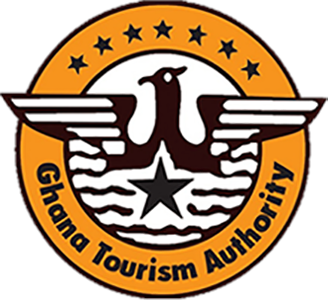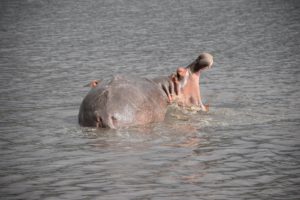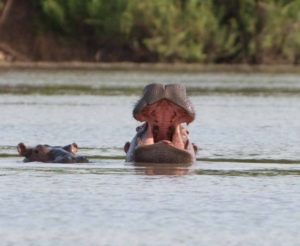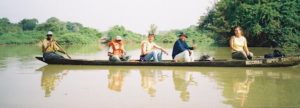Wechiau Adventures 3
The third episode of Kofi Akpabli’s Wechiau Adventure
Having seen all I wanted to see I signalled to my party. Before we set off, our boatman decided to scoop out water from the canoe. Shortly after we set sail, we met another boat with a white couple. They wove gingerly to us. Getting to Wechiau is a rugged adventure still an encouraging number of visitors manage to come for the experience.
River Safari
Our river safari ended at Talawona where it had started. The name of this place means ‘‘I do not ever want to hear again.’’ It expresses the aspirations of the Lobis who settled here after escaping from constant battles in Burkina Faso. Back on land, we joined my rented car for the 18 km trip to Wechiau.
About ten minutes after we hit the road, we stopped at the Talawona Tourist Lodge. Built in an authentic Lobi style, the accommodation is basic but comfortable. Each room has three single beds covered with a mattress and mosquito net. There is a kitchen, a dining hall and cooks on the ready.
Where to stay
For lodgers who like the outdoor, there is a brilliant idea of a platform mounted up against a kapok tree. Some tourists prefer sleeping there for breeze and closeness to nature. Given the chance, I would love to observe sunset from there.
When we resumed our return trip, we made a number of stops at Lobi compounds. What fascinates me most about northern traditional buildings is the barn. It is basic to the architecture. Much skill goes into how different types of crop harvests are stored and retrieved. I find nothing more secured than living in your own house with your kinsmen with all your food supply for the season right under your watch. Kind of reminds you of Noah’s Ark.
We also stopped by a compound where akpeteshi was being distilled. One would think that this local gin could only be produced in palm or sugar cane growing areas. Well, don’t you wonder anymore. Here, they use sugar as the base for the preparation. We got there at a time the hot stuff was piping out from a barrel into a sieved jar. The smallish distiller and his party were excited the way schoolboys are when their pranks lead them to a positive discovery. They were eager that I have a sip.
Now, there is this thing about village folks. Here is a business unit that has invested so much in a venture. Just as all is set to break even, up comes a gallivanting stranger from God-knows-where and everyone is excited about me participating in their enterprise. That doesn’t happen in A-c-c-r-a.
Ghanaian warmth
This genuine warmth towards the next fellow is something city people usually lack. It has to do with an innocent desire to share. Well, bottom-line? Akpeteshi was being offered. So who am I to spoil the goodwill of such kind, innocent souls? Let’s just say there was a swallow. And I got an ovation for that.
Back in Wechiau town, I walked to the visitor centre of Wechiau Community Hippo Sanctuary. It is one large room which serves as an office, showroom and meeting place. Appropriately, the white, huge skull of a hippopotamus is positioned to welcome you.
The information and finance officer, Abdulai Issahaq received me. It was a busy day for him because it was Wechiau market day. Those visiting included tourists, rangers, and project volunteers from the 17 communities that form the Sanctuary. The centre employs five tour guides, five administrative staff, 10 rangers and 15 boatmen.
I saw souvenirs of tiny hippopotamus made in clay. The walls of the visitor centre are pasted with items that tell the story of the place. Through the efforts of Nature Conservation and Research Centre, an NGO, the Wechiau Hippo Sanctuary project has been linked to the Calgary Zoo of Canada. The Dutch Development Organisation, SNV is a partner to the project.
Quite naturally, awards and citations decorate the walls. Among them, ‘‘Community Initiative in Tourism Development’’ won at both Regional and National levels. There is also the SKAL International Award for 2006. I saw the framed photo of the Paramount Chief of Wechiau in a pose during an invitational trip to Canada.
From the centre, I went through town to have a feel. The area you would call the centre of Wechiau town has an unfenced mausoleum. The oldest tomb there is for a chief called Naa Daguo who was buried as far back as 1910.
For entertainment, there is a xylophone music session that can be arranged. Night life in Wechiau is supported by three well-dispersed drinking bars. There is a video centre that runs on a very smoky generator. The night before I had seen children barely in their teens watching the film, ‘‘Lost in the Jungle.’’
WECHIAU ADVENTURE 2
This the second episode of KOFI AKPABLI’s Wechiau Adventure
Thanks to the community owned and self-managed Wechiau Hippo Sanctuary Project, social amenities have been brought to people’s doorstep. Wechiau town and the sixteen communities involved in the project have solar power that lights up their lives. Also, they need not drink from the Black Volta and risk guinea worm and bilharzia anymore. There are boreholes that pump up safe drinking water.
When they do get ill, a 24 hour health centre at Wechiau is there to restore health. The number of schools in the project areas has also increased. The influx of visitors sparks up demand for local goods and services.
We rowed across floats hooked to fishing net. The fish trap is set in the morning and then harvested in the evening. Life in the Black Volta includes cat fish, mud fish, tilapia and crocodiles. Fishing is the only activity allowed within the sanctuary. hunting and farming along the river are strictly prohibited.
Hippos and birds?
Once in a while, we heard a piece of bird song; a chirp here, a coo there and a warble across. When these sounds were stringed together it was a choir act. If we had come at dawn, we would have been entertained to a symphony. The Wechiau Sanctuary is also a bird lover’s paradise. As many as 200 bird types have been documented. Any expert in ornithology would tell you that is a world class collection.
The names are as interesting as the species vary; Red-bellied Paradise Flycatcher, Yellow-throated leaf love and Western-banded Snake Eagle. Others are Four banded Sandgrouse, Senegal thick-knee, Greater Blue-eared Starling and Exclamatory Paradise Whydah. My tour guide took pains to point out the species. But with hippos on my mind I really couldn’t care much for birds.
One big one flew above us, went further up and swooped down, angling for a fish. In a flash, it was up in the air again. ‘‘Is that a kingfisher?’’ I asked, more in a bid to show that that I am not green. The predator’s manoeuvre was just like you see in wildlife films on TV. Only when I looked up hard at the bird, I could not see a fish in its claws. A miss, maybe.
By now we had done about half an hour. In my eagerness, I really thought we had gone past one hour. Not too far ahead I could see the famous Tukpon Island. Also known as Tankara, it is the biggest of all the islands within the river sanctuary. The spot is an important landmark as it served as the hide out for natives escaping from raiders during the Trans-Atlantic Slave Trade.
Game at last
A dark, round-like shape jutting out of the river appeared within sight. I thought to myself, ‘‘game at last’’ and raised the alarm. It turned out to be a rock. Agbai advised that I should calm down. He assured that it was a good day to find hippos.
It is not everyday that one spots hippos at Wechiau. The best time is during the dry season spanning October to May. During this period the water level comes down and the animals cannot easily hide.
My guide drew my attention to a series of large muddy holes that led from the water vanishing in the undergrowth. He said they were the footprints of a hippo. Hippos are amphibious, meaning they live the double life of water and land creatures. They choose to leave the water at night to hunt for food on land.
The silence on the Volta was suddenly broken by a noise like the fast rush of water. Before I could ask, it came again; this time sounding like the puff of a heavyweight punch. I was not brave enough to turn and face Agbai for feedback. But I hear his ‘‘yes, yes’’, over my shoulder. I open my eyes wide. I see nothing. Then the silence returns. What was that noise?
‘‘A hippo is breathing’’, said my tour guide.
As we rowed nearer, something emerged. And quickly submerged. Agbai instructed that I keep my eyes on the spot. I did, yet all I could see was that the water in the area seemed to boil and boil and then… up rose the beast!
First thing that came to my mind was ‘‘reared its ugly head.’’ The phrase came home to me as a combination of power and movement and sound broke the calmness of the morning. At that material moment, I realised that I have finally come face to face with the object of my mission.
My record check showed that the spectacle was taking place exactly after 56 suspenseful minutes of boating. My reality check confirmed that after a few seconds, the animal was still in front of me. It was big, dark and leathery. But the real colour was something between brown and dark. A close look would show other shades.
What was more definite, however, was the monster’s ugliness. The hippo is ugly, in a way that commands you to watch. Like all big animals, it carried an air of majesty though awkwardly. Our hippo shook itself and then lowered its body. The head remained above water.
Broad snout with large mouth…
Quickly, I jotted down the vital statistics: broad snout, large mouth, short barrel-like body. Eyes, ears and nostrils are located on the top part of the head. And they all protrude. This facial set up allows the hippo to rest its whole body in the water, while still able to see, hear and breathe.
Hippos come up for air every 6 or 7 minutes, but when under pressure they can hold their breath under water up to about 30 minutes. The act of surfacing and breathing is automatic to the hippo. Even when in a sleeping state underwater, this animal will rise and breathe without waking.
I did not know when that was done but I realised that our canoe had virtually stopped and we were just floating around one spot. I noticed that we had ‘‘parked’’ by a rock to see action. Abdulai had got up and jumped to the top of the rock.
I was instructed to turn and face the beast. I turned slowly from my bench, checking to be sure that the straps of my life jacket were in place. I sat with a leg on each side of my canoe seat. Now I could see better action. Kassem, the camera man also positioned himself to take action shots. Between us and the hippo I could estimate a respectable distance of about some 50 metres. I hoped the hippo also sees 50 metres as respectful enough.
In my new position, I had full view of the animal. The Lobis call hippopotamus ‘‘kaka.’’ Make it ‘‘kakai’’ and you have the southern Ghana word for beast. A little towards our left, two more showed up. Agbai explained that it was a mother and child situation. Like humans, hippos normally give birth to one baby at a time. Their interval between births is two years. They are also social animals. They believe three is a crowd and thus like moving in pairs and sometimes alone. When they can’t help it, they form part of a larger group.
Another bloat of two hippos emerged. In all, there are twenty odd members in the sanctuary and that is quite a crowd. We watch the newcomers play. Though clumsy in appearance they seem graceful in the water. On land, hippos can easily outrun humans, in spite of their stocky shape and short legs. They have been clocked at 48 km/h while running short distances. If you are fussy with records, that is faster than the speed of an Olympic sprinter.
Endangered Species
Although the hippo is not yet endangered, its habitat has been greatly reduced over the last 200 years. All over the world hippos are prized for their teeth which are superior to the elephant’s ivory. Their hide is also considered valuable. I ask Agbai about poaching. No hippo has been killed at Wechiau in recent memory. That speaks volumes for the cooperation of the communities.
Another reason may be because the hippo is among the most dangerous and aggressive of all animals. It is considered to be Africa’s most dangerous. When you put a bullet through it, for instance, you must be prepared to chase miles after it before you can get its body, that is if it falls at all. As a hippo’s anger grows it keeps ‘‘yawning’’ and then, shows its big teeth. A hippo’s jaws are capable of biting a 10-foot crocodile in two. Any question?
But hippos have their soft side too. Like humans, they are quite shy especially when in small groups. They can also be tolerant with birds pecking food from their backs. Even turtles and baby crocodiles are free to enjoy the sunshine on them.
The hippo’s feeding habit also is another paradox. Here is a creature which can go for three weeks without feeding. But when it wants to eat, the hippo grazes for five hours non stop. In one night it can consume 68 kilograms of grass. Now, that is equivalent to the weight of a fully grown man.
Some people think the hippo sweats blood. This is because of the pinkish, oily liquid that sometimes oozes from their skin. But this is not blood. In fact, the hippopotamus does not sweat. They do have a thin skin that easily dries out. And when out of the water for a while this liquid prevents the skin from drying out and acts as a sunscreen.
A hippo’s lifespan is usually 40 to 50 years. In captivity they live longer than that. The oldest hippo ever was called Tanga. She lived in Munich, Germany, and died in 1995 at the ripe age of 61.
– Kofi Akpabli is a travel writer
THE WECHIAU ADVENTURES
This the first episode of KOFI AKPABLI’s (travel writer) Wechiau Adventure
Mission
The vehicle to accomplish the mission was not much; a narrow, 15 foot canoe made of mahogany. After travelling 899 km from Accra, and after countless daydreams and night ones, my moment of truth came when we hit the river. It rolled out vast and as far as the eyes could see.
I was first to face the Black Volta. Behind me, a file of four. These were men I had met for the first time barely an hour ago. But all were playing no small role in the expedition. Sitting directly after me was Agbai Issahaq, my tour guide who was followed by Kassem, the local photographer. Next sat Abdulai, the driver who brought us from Wechiau to the water front at the cost of 20.00 Ghana cedis. At my opposite end was the boatman with the paddle. He is a mere 19 years. Hassan is the lad in whose hands my life rested. I made a mental note to tip him extra after the safari… if I survived.
We cruised at a leisure pace watching banks of savannah forest pass us by. Having quite settled on my piece of seat, I dipped my entire palm in the water and brought it out. The Black Volta felt milky, tasted clayey and smelt odourless. This is the water body that is home to the most famous hippopotamus family in Ghana. It is also international territory. The bank on our left is Ghana and on our right, the Republic of Burkina Faso.
If we continued at our pace for seven days and seven nights, we would appear at Bamboi in the Bole District of the Norther Region. The stretch we were riding is part of the 40 km long Wechiau Community Hippopotamus Sanctuary. Our mission? To spot hippos.
Hippos?
The hippopotamus (Hippopotamus amphibius) is the largest mammal on land, after the elephant. It can weigh up to 4000 kilogrammes – the weight of three saloon cars mashed together. An interesting fact about the hippo is that it is one animal whose species status baffled scientists for a long time. Centuries ago when the Greeks first encountered the creature they named it based on two concepts, hippos meaning ‘‘horse’’ and potamos meaning ‘‘river’’.
But new knowledge later showed how wrong the Greeks were. The hippo does not belong to the horse family. At a point, some naturalists considered it a species of the cow. In fact, the female hippopotamus is still called a cow, its male a bull and the baby a calf. But it was discovered that the hippo is not related to the cow either.
Because of its dental formula, a section of the science community used to believe that the hippo is a type of pig. This view was further supported by the fact that it has a ballooned body supported by short, stocky legs. Again, that also proved to be wrong. As a matter of fact, the closest cousin of the hippopotamus turns out to be the whale.
As we sailed on the trail of the hippo, I could not help but feel an eerie silence. It was the kind of heavy hush that you feel in large, lonely places. It was so quiet, each time a big fish got excited we heard the splash. Meanwhile, the sun, after much hold up by rain clouds, was now showing its presence by shimmering on the water top…
Where is it?
The Wechiau Hippopotamus Sanctuary is located in Wa West District of the Upper West Region. Wechiau, (pronounced ‘‘Wey-chao’’) has since 1999 been one bright community based tourism project. According to local sources, the place got its name from the phrase ‘‘to cut’’ in Wechegii dialect. Oral tradition says that prior to settling in the area, the founders had to cut a mighty amount of forest. Other versions allude the name to a native who was trying his hands at English and instead of saying ‘‘we cut’’ ended up saying ‘‘we chao’’.
Whatever the source of its name, Wechiau has cut a good image for itself as a tourist destination. A glance at the visitors’ book at the reception shows a rich mix of visitors from all parts of the world. Close to Burkina Faso as well as La Cote D’Ivoire, the attraction is a must see for the adventurer who also wants to experience nature and culture.
Side Attraction?
While hippos happen to be the star attraction, there is more to the area. A 300 year old mosque is worth seeing. It was built by Liman-Yiree who came from Kpong in Cote D’Ivoire. There is also a botany walk for those interested in plant life. In addition, the sanctuary is home to monkeys, bats and three species of antelopes.
Wechiau society itself is a fine showcase of how a variety of distinct cultures can exist in harmony. Together, the Wechegiis (Walas), Lobis and Hausas have blended their ways of life, same way as they have preserved their identities.
The Lobis, for instance, enjoy a high standing in international cultural circles. Also found in Burkina Faso and La Cote D’Ivoire, the Lobis are a people who avoided European contact as much as they could. The French, for example, feared them for their poisoned arrow resistance to colonialisation. Thus, very few are the Lobis, who are either Christian or even Muslim.
There is extensive documentation of Lobi sculpture, customs and architecture in world literature. Also known as the Birifor, they are noted for piercing the lips of their women. But that was then. Today, of course, a young Lobi lady would rather have her lips greased with designer lip shine.
As we continued our boat ride, I heard a ‘‘yooo!’’ that rung through the forest. I noticed two fellows standing by the river on the Ghana side. Agbai pointed at a small canoe tied to a tree at the Burkina side. ‘‘They are calling for the boat.’’
The boatman is on the French side, stationed not far from the boat. He would hear the call, row across to the other side and ferry the passengers. It takes about ten minutes and costs 2 Ghana cedis. The equivalent in franc CFA is accepted.
‘‘What if you cannot afford?’’
‘‘You swim’’, replied Agbai.
He was not being sarcastic. Poverty in these parts is a very familiar reality. In the absence of any local industry, the youth here are limited to what their ancestors have always done, catch fish and till the land. The more ambitious among them engage in the ‘‘energy sector’’, that is, burning fuel wood for charcoal.


 Call Center
Call Center



 Call Center: 0307007100
Call Center: 0307007100